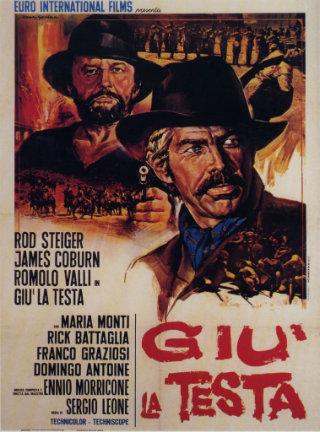
I know what I am talking about when I am talking about the revolutions. The people who read the books go to the people who can’t read the books, the poor people, and say, “We have to have a change.” So, the poor people make the change, ah? And then, the people who read the books, they all sit around the big polished tables, and they talk and talk and talk and eat and eat and eat, eh? But what has happened to the poor people? They’re dead! That’s your revolution.
For someone who has dedicated so much time to writing about westerns, I’ll have to admit I have thus far neglected one of the best known directors of the genre: Sergio Leone. The truth is that, outside of Leone’s work, I cannot claim to be a huge fan of the spaghetti western sub-genre. So, while I have reservations about the Euro western in general, I have no hesitation at all acknowledging the artistry and sensibility of Leone. He didn’t actually make a large number of westerns, but those which he did have been highly influential. Once Upon a Time in the West has probably come to be accepted as his crowning achievement. While I have no intention of challenging that assertion, I do believe that A Fistful of Dynamite (1971) runs it a very close second in terms of emotional and intellectual depth.
The setting is Mexico during the revolution, and this provides the ideal background for Leone to lay out his thoughts. It affords him the opportunity to make points of both a political and personal nature, and weave them together into a critique of the direction of contemporary filmmaking. If Ford and Peckinpah had helped deconstruct the myth of the west, and paved the way for the emergence of the spaghetti western, then Leone (critically lauded as a cinematic revolutionary) set about the deconstruction of the myth of revolution itself. The film opens with Mao’s quotation describing revolution as being essentially an act of violence, and the events that unfold on the screen back up this assertion. Yet Leone, in his depiction of the frequent and mindless violence, never glories in the bloodshed. The film we see is a tragedy, a very human one, but at the same time it’s a celebration of friendship and kinship. We follow the fortunes of two men, John Mallory (James Coburn) and Juan Miranda (Rod Steiger) as they navigate the danger and treachery of a country in upheaval. John is an IRA man, an explosives expert on the run from his native land plying his trade in the silver mines. Juan is a bandit, a simple peasant content to live off whatever pickings come his way. A chance meeting draws these two contrasting characters together and binds their fates inextricably. Initially, each man views the other as a kind of dupe, a tool to be made use of to further their individual ends. Juan sees the Irishman as the means by which he can finally crack the famed bank in Mesa Verde, while John regards the Mexican as someone he can trick into serving the revolutionary cause. The first half of the movie takes us through the twists and turns of his mismatched duo’s effort to stay one step ahead of the other. The tone is light, bordering on the comedic at times, but the clouds are gathering in the background. The aftermath of the Mesa Verde escapade ushers in the second, darker part of the story. It’s here that the full import of the political situation starts to become clear. Where the violence of the earlier section had a cartoonish quality, the deaths that follow (and there are many) are cruel, and they have consequences. The romance of revolution is laid bare before us, both in words (see the opening quotation above) and actions, and it’s not a pretty spectacle. Leone’s controversial assessment seems to be that betrayal and loss – of family, friends and ideals – are both the result and foundation of revolution. That’s a brave and daring position to adopt at any time, and even more so in 1971 following hot on the heels of the previous decade’s climate of political, cultural and social change.

For the most part, A Fistful of Dynamite follows a traditional, linear narrative structure. However, there are teasing flashbacks interspersed throughout, each one adding to and expanding on those that precede it. These flashbacks relate to John’s past life in Ireland, and show Leone’s gift for inventiveness by gradually revealing the character. In fact, they work on two levels: (i) they act as an homage to Ford, by evoking the Irish preoccupation with betrayal as seen in The Informer and (ii) they delineate the background of John, simultaneously marking him out as a western hero in the classical mold. Leone was greatly influenced by Ford – a section in Christopher Frayling’s first class Once Upon a Time in Italy reprints a 1983 interview Leone gave an Italian newspaper, where he details his reverence for Ford and tells how he had a framed photo the latter had signed and inscribed in his honor occupy pride of place on his wall. In purely narrative terms, the flashbacks not only flesh out the character of John but they help explain why and how he came to this place in his life. John is essentially an enigmatic character, a man whose motivations are hard to divine, yet the brief interludes in Ireland allow us to build up a near complete picture of him by the end. By charting his descent from romantic idealist to disillusioned technician, the flashbacks both fill in the gaps and establish his western credentials. At first glance, an Irish bomber involved in the Mexican revolution might not appear to be a traditional western figure, but an examination of his character arc – betrayal, revenge, guilt and the quest for spiritual redemption – tells the tale. This lone figure, this outsider with a heart full of regret, searching for a way to bury his past is a recurrent one in the classic western. As such, John moves from apparent cypher to an incredibly complex man, a walking tragedy who seems destined to enter a new cycle of guilt and remorse – his involvement of Juan in his schemes brings only misfortune, and the matter of betrayal once again rears its head. The explosive finale, therefore, represents the only possible way for him to achieve a form of closure and inner peace. Coburn really got under the skin of John, maybe not quite reaching the levels of self-disgust he managed when playing Pat Garrett for Peckinpah but not far off either. The climactic scene on the engine plate with the traitor Villega (Romolo Valli), where he vows never to pass judgment on another man again, is a masterclass in bitterness and loathing.
By contrast, Juan is a much more straightforward character, a simple man with simple dreams. However, he too has to suffer at the hands of idealism. He’s well aware of the hypocrisies and false promises held out by the revolutionaries, yet he allows himself to be drawn ever deeper into the machinations of John and Villega. His casual vulgarity and lack of sophistication mark him as a semi-comedic everyman, someone whose attachment to family allows the audience to sympathize with him despite his being a common criminal. By having the audience view proceedings mainly from Juan’s perspective, Leone manages to hammer home the abrupt shift in tone at the halfway point much more effectively. The fate of his extended family, a direct consequence of his greedy foolishness and unwitting embroilment in politics, hits both him and us hard. The scene in the cave, with a bewildered and grief-stricken Juan stumbling around amid the carnage, is extremely moving no matter how often it’s seen. It brings both the film and the character to a new level, and neither one is ever the same again. Juan is transformed form a gregarious rogue with grandiose plans first to an image of despair, and then to something harder and colder. As an actor, Rod Steiger generally had a tendency to overcook it, to chew up the scenery before moving on to the props for afters. That is certainly in evidence in the early stages, where he is essentially a caricature of a Mexican bandit. However, he was capable of greater subtlety when the occasion demanded, and his reaction to the discovery in the cave, and all that follows, bears testimony to that. Steiger managed to tap into the development of his character, the journey he has taken, but still hold onto a touch of the innocence that makes him endearing. The final fadeout, with Juan’s moon face staring dumbly into the camera lens as his question is heard and the answer flashes before us, underlines Leone’s feelings and highlights the pitiful quandary faced by all of us.

Of course it would be impossible to discuss any Sergio Leone film without also referring to the music of Ennio Morricone. To any film fan, the names of the director and composer are inseparable, and the two men seemed to draw the best from each other. Morricone’s scores are always distinctive, primal pieces that complement the harsh landscapes and off-center characters in Leone’s films. For A Fistful of Dynamite, Morricone created music that was quite unlike the work he did on the previous Leone collaborations. There’s a light, jaunty quality to the scoring in the early scenes that matches the initial buffoonery of Juan and the ribbing of John. This gives way to the lush romanticism of the pastoral flashbacks and the ethereal vocals repeating the name Sean over and over. And finally, the more somber variation on that theme as the flashbacks grow darker and knowledge of what John did to his friend (Sean?) becomes apparent. One of the features on the DVD actually raises that question – who is Sean, and why does John call himself that at first? Of course, Sean is often used in Ireland as the Gaelic form of John, but Leone’s cutting of that scene and the use of the music therein does suggest some kind of transference is taking place, that John’s guilt is subconsciously driving him to adopt the name of his friend.
And finally, a word on the title. This movie has been known under a number of titles: Giù La Testa, Duck, You Sucker!, Once Upon a Time in the Revolution and A Fistful of Dynamite. The original Italian title arguably captures Leone’s message most succinctly – a plea to keep a low profile and thus avoid unwanted political attention and trouble – but the translation into English loses much of that and actually suggests some light-hearted romp. The other two alternatives both represent attempts to draw connections to and capitalize on Leone’s previous successes, but neither is really satisfactory either. In the end, I opted to use A Fistful of Dynamite to head the piece here mainly because that’s the one I’m most familiar with, and it’s also emblazoned across the cover of my DVD.
A Fistful of Dynamite is a movie that has been released in different forms over the years, but the 2-disc DVD from MGM presents the definitive cut. It restores the full, extended flashback at the end of the film and the title of Duck, You Sucker as it fades out. That full flashback, with its dreamy feel, is vital in fully understanding the relationship between John and his friend back in Ireland, and adds a different twist, a shade more ambiguity, to his actions. I’d hate to be without it. The edition is stacked with fascinating extras, not the least of which is an excellent commentary track from Sir Christopher Frayling. I have no particular complaints about the anamorphic scope transfer but I still feel it’s a pity it has yet to be released on Blu-ray. Among Leone’s films, this title sits alongside Once Upon a Time in the West in my affections, and might just edge it out. Objectively, it may not be the better film, but it has a kind of romanticism, and disillusionment – and what’s disillusionment but wounded romanticism anyway – that stirs something in my Irish blood. I don’t know, it’s a film I love – that’s as much as I can say.
